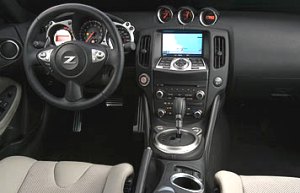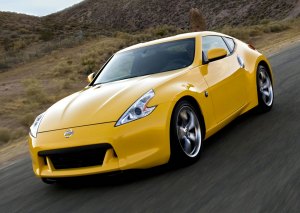|

|
After changes and changes, the
Fairlady starts playing consistently now...
|
Although I have been
following
the Fairlady for more than 20 years, I still can't say myself fully
understand her. You can't figure out what she is because in different
time she appeared in different form and character. The earliest
Fairlady was a little roadster in the mold of MG or Triumph. It
suddenly became a Ferrari-style sports car in 1969 (240Z), then
softened into a grand tourer (280ZX and the first generation 300ZX). In
1989 it was revitalized as a high-tech, high-performance Porsche-beater
(2nd generation 300ZX). 13 years later, it dumped all fancy
technologies and luxury and simplified itself into a brutal 2-seater
sports car (350Z). For sure, Fairlady can play magic and convert
herself into different figures as wish. However, an inconsistent image
does not help building a nameplate. Without a prestige nameplate, you
can't charge more money than the competition. This is why 350Z could
charge only half the price of a Porsche Cayman.
Anyway, Nissan starts playing more consistently now. The new 370Z
follows the same simple format of the old car. It is built on the
second generation FM platform sharing with various Infinitis, with a
big naturally aspirated V6 mounted longitudinally up front and drives
the rear wheels. Suspensions are double-wishbone type up front
(replacing the outgoing multi-link) and the rear remains to be 4-link.
To keep it affordable, 370Z resisted to employ most sophisticated
technologies widely available to its rivals, such as adaptive damping,
twin-clutch gearbox and active differential. It also does without the
increasingly popular multi-mode integrated control system. No wonder
its base price is just over US$30,000 in the United States. Even the
car equipped with Sport Pack (which includes 19-inch wheels, sportier
tires, larger brakes, LSD, Synchro Rev gearbox and additional spoilers
that eliminates aerodynamic lift and reduces Cd to 0.29) will cost no
more than US$35,000.

|
The roof line now drops gradually and
merge with the tail - an attempt to look like 911 ?
|
Its exterior design
is
also an evolution of 350Z. The muscular, brutal profile is kept, but
there are lots of subtle refinement. There is now far more surface
tension throughout the body. The flanks are more pronounced to cover
the wider tracks. The roof line now drops gradually from the A-pillar
towards the tail and merge with the latter - an attempt to look like
911 ? However, not everything is positive to me. I am not pleased with
the gimmicky L-shape headlamps and taillights because they are rather
unnecessary. Same reason for the sharp angle between A-pillar and roof,
which was taken from GT-R. The tiny quarter windows won't help
rear-quarter visibility. But most disgusting is the front intake,
because it looks like a bloody big mouth with a pair of Vampire's teeth
! I suppose a black 370Z would be the perfect car to attend Halloween
party.
I also dislike the interior design of this car, as the organic theme of
its plastic dashboard and transmission tunnel is outdated. There are
many alloy inserts here and there, but you can easily spots most of
them are fake. The handy 3-gauge instrument pod remains. It continues
to be adjustable for angle together with the steering wheel.
Unfortunately the latter is not adjustable for reach. The manual seat
adjustment is another signs of cost control to enable a low price.
Nevertheless, soft plastics are used throughout the cabin now, which
makes it feel far more expensive than the low rent cabin of 350Z.

|
The organic theme is outdated, though
soft plastics lift quality feel...
|
The new chassis is slightly wider
and lower than that of 350Z. In order to improve its agility, Nissan
shortened its wheelbase - which was admittedly too long at 2650 mm - by
exactly 100 mm. Shorter wheelbase also helps improving chassis
stiffness, so torsional rigidity has been increased by 30 percent up
front and 22 percent at the rear structure. Better crash protection,
higher quality standard and equipment means the Z-car needs some diet
to keep weight down, so it adopted aluminum bonnet, doors and tailgate.
The front radiator housing and driveshaft are even made of carbon
fiber. Nissan claimed the new car is 43 kilograms lighter than 350Z,
but in reality a 370Z Sport is proved to be sightly heavier than the
equivalent old car. Moreover, at 1530 kg, it is by no means
lightweight. For comparison, a manual-gearbox Porsche Cayman S weighs
only 1350 kg.
Nissan said its handling is improved by the wider tracks, shorter
wheelbase and a slightly lower center of gravity. The latter is
achieved by mounting the engine 15 mm lower and the seats 10 mm lower.
However, what Nissan didn't tell us is the front-to-rear weight
distribution has been worsened from 53:47 to 55:45, blame to the
3.7-liter engine, which added 19 kilograms to the front axle.

|
What Nissan didn't tell us is the
front-to-rear weight distribution has been worsened from 53:47 to
55:45, blame to the 3.7-liter engine...
|
On the road, however, 370Z Sport is
better than its predecessor in any respect. Its massive Bridgestone
rubbers (245/40WR19 front and 275/35WR19 rear) generate tremendous
grip. Its large brakes (355mm front and 350mm rear, with 4-pot and
2-pot alloy calipers respectively) provide powerful stopping and good
pedal feel. Its body control can be described as rock steady, accompany
with a firm but controlled ride. Its steering is more weighty, precise
and direct than before. Besides, less understeer is displayed near its
limit.
However, with more weight over the front wheels, it never feels as
agile as the mid-engined Cayman. Its cornering prowess is gifted by its
grip and roll resistance rather than chassis balance or steering feel,
which is less tactile than Porsche. This mean while it is a clear
improvement over 350Z, it is neither as talented nor as entertaining to
drive as Porsche. It also rides harder and generates a lot of tire
roar, thus it is not as good as a daily companion. Despite of the
refinement, Nissan still leaves some brutality and rough edges intact
in 370Z.

|
If you cannot afford the Porsche, this
will be the next best thing.
|
The same goes for the new VQ37VHR
motor, which comes from Infiniti G37. On paper, you have to pay the
highest tribute to it. It has dual-continuous variable valve timing and
a low-inertia continuous variable valve lift mechanism to ensure high
output and efficiency. It produces 332 horsepower, versus the previous
306 hp. Redline is raised by 500 rpm to 7500 rpm, yet it returns lower
fuel consumption. Unfortunately, its refinement has taken a backward
step. You might remember the original 2.3 and 3.0-liter VQ engine was
renowned for smoothness. Now with capacity stretched to 3.7 liters, it
finally reached its limit. When it approaches redline, its
soundtrack gets coarse and itself starts vibrating. The latter can be
felt by the driver through the throttle pedal and gear selector. What a
pity, because the powertrain is otherwise flawless. The 6-speed manual
transmission is especially a joy to use because it has a facility to
blip throttle automatically on down change, so the rev is matched and
smoothen the transition from one gear to another, very much like an
automated manual gearbox.
Capable of accelerating from rest to 60 mph in 5.1 seconds and 100 mph
in a little over 12 seconds, Nissan 370Z is very fast without doubt. It
cannot beat a BMW 135i Coupe in straight line, but comparing a
thoroughbred sports car with a civilized coupe is pointless. The only
comparable car is again Porsche Cayman. A base Cayman 2.9 takes 5.6 and
13.4 sec to do 0-60 and 0-100 mph respectively, which is obviously not
in the league of 370Z. A Cayman S with PDK gearbox is barely faster at
4.9 and 11.2 sec, but it costs nearly twice the price. If you cannot
afford the Porsche, this will be the next best thing. |